How to Reignite Your Cold Outreach Strategy During the COVID-19 Crisis
Jenny Keohane
These times are tough and we hear each and every one of you. At Yesware, we’ve had countless conversations with sales reps whose inbound leads are drying up, putting them in a position where they need to reignite their cold emailing/cold calling game and fast. This is causing many reps to make the transition to a full inside sales strategy at the drop of a hat.
We’re here to help.
We’ve pooled together our best cold outreach resources, formulas, sales techniques, and data to provide you with an all-in-one guide to help you reignite your cold outreach strategy during these uncertain times.
Table of Contents
Bonus: Navigating Cold Outreach Webinar
Cold Outreach: Cold Calling
First, we’ll dive into cold calling.
This section will consist of cold calling steps, scripts, and tips.
Cold Calling Steps
First step: Research
Researching your prospect should be a pre-call ritual. By tracking down key information about your prospects, you can deliver calls with value and keep their attention.
Without research, you appear selfish by showing zero investment in the person on the other end of the phone. Your prospects will appreciate the extra effort made with personalization and will open up the call to better conversation.
Go to your prospect’s company website and hit each of these four key pages before you call:
- About Us
- Careers / Open Positions
- News
- Blog
About Us page: Keep an eye out for mutual acquaintances (investor, board member, or even mutual customer) that you can reference on your sales call. If your prospect hears that someone they know trusts your company, they’ll be more likely to give you the time of day. That’s the power of social proof.
Careers page: Open job listings will often include what software the company is currently using and the pain points they hope to fix with a new hire. Can your offering help them with these pressing issues?
News section: Look for triggers or action events that align your offering with the company’s immediate needs. Not only is it an excellent conversation starter, but it also shows that you’ve done your homework, which is psychologically proven to make people more motivated to help you in return.
Blog: Don’t spend too much time here—just a quick scan to see what the company is talking about and if your prospect is actively contributing.
Also, make sure to look at their LinkedIn page.

See if you have any mutual connections or past experiences you can connect with. It can also be helpful to check their other social channels for more information, but be mindful of this.
Lastly, never forget to check your CRM system.
Quickly scan to see the lead source. If your prospect has engaged with your marketing content in the past (landing page visit, eBook download, webinar sign-up, etc), you can reference this on the sales call. Also, look for notes on past interactions with other sales team members and what (if anything) happened.
Second step: Write an outline of what you want to say
Writing an outline is the best way to make sure you hit the right points during your call.
Write up a quick (30 seconds or less) cold call script that you can reference on the phone. The idea isn’t to read from this verbatim but to use it as a guide to help you communicate your message clearly and confidently.
Remember: your goal isn’t to pitch someone on the spot, it’s to get them to commit to a meeting.
Third Step: Choose the right time
If you’re not sure where to start – try Tuesdays, Wednesdays, and Thursdays. Various studies indicate different best days/times to cold call but all studies have one major similarity: the worst day to call is Friday.
Many studies indicate the best time to call is between 8am-9am and 4pm-5pm.
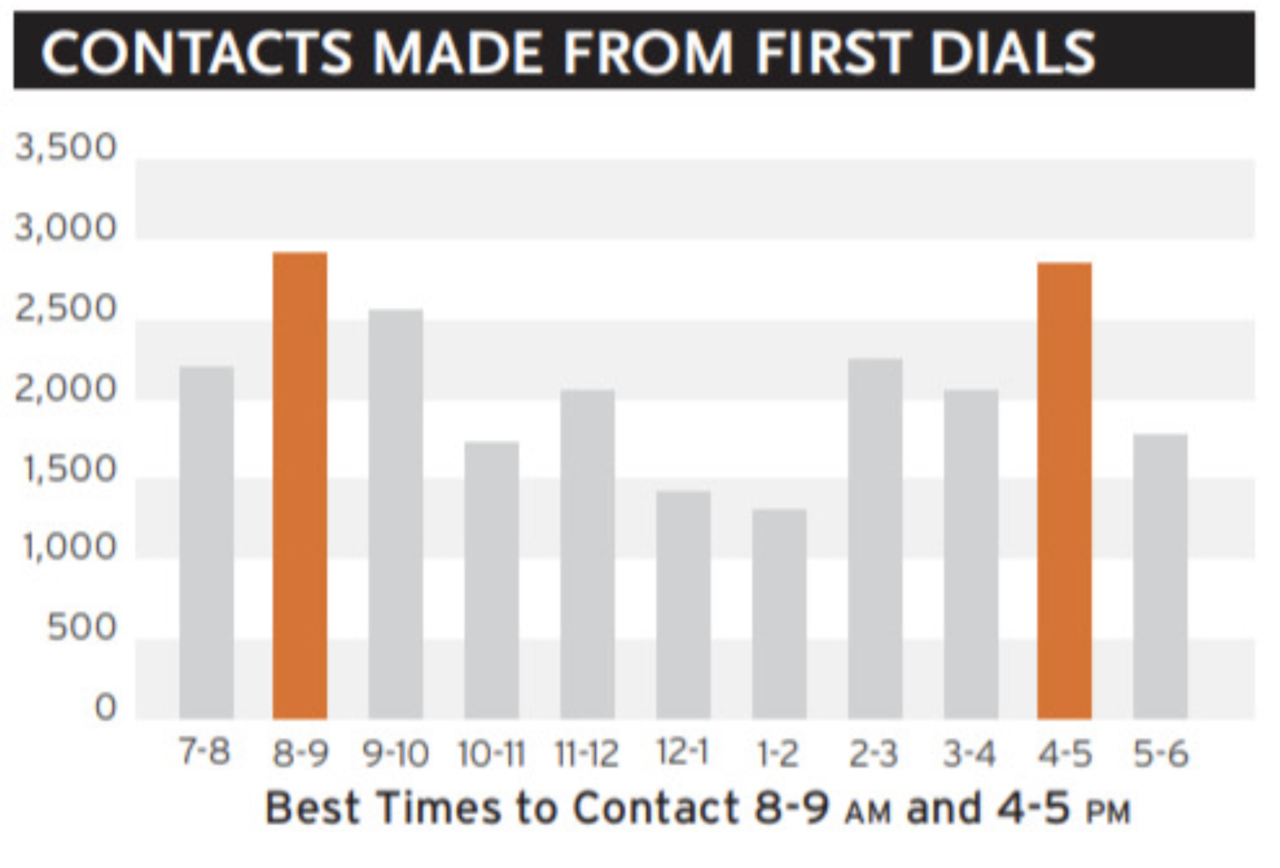
A Yesware analysis of over 25,000 calls made through our phone dialer discovered that sales calls lasting over five minutes most often occur from 3:00 to 5:00 PM on Tuesdays and Thursdays.
There is no “perfect time” – the key is to try different times and see what times work best for you and your clients. Pick up on patterns and stick to where you see the most success.
Ready, set: Time to call
Here’s what you’ll need: your prospect list (ideally with prior research about the person), your sales call script, and a place to jot down call notes.
And remember: on your call, keep it conversational, personable, and concise. Communicate value and a reason for calling – you don’t want to waste either of your time.
Cold Calling Scripts
Completely Cold Outreach
Always personalize your call scripts to the person, role, and account you’re prospecting to, and tweak it according to what works.
If you’re calling someone who’s never talked to you before, they will likely be on the defense: Who are you? Why are you calling me? What are you asking for? Your sales call script needs to answer these questions clearly and concisely.
Here’s a secret: You both share a similarity.
You and this person have something in common—a background, a hobby, or a piece of knowledge. Maybe you went to rival colleges, or are big fans of tattoos, or have worked with the same person in the past. A Facebook Study proved that the degrees of separation between strangers is smaller than we all thought – it’s only 3.5 people.
Finding your commonality (and bringing it up in a natural way) makes you more attractive to your prospect.
How to get there: From your research, find a compliment or a specific pain point. Your acknowledgment of this intimate fact can serve as your bond. Then, come up with a connecting statement for your sales call. Something like this:
“Hey, I happened to notice that you’re connected to Sarah Cuddy. I actually worked with Sarah up until last year at LiveCourse. She’s great to work with!”
“I’ve had my eye on RealDrive for a while as an awesome company, and I noticed that your team is hiring for a Sales Operations role. Congratulations on how fast your scaling! I see you guys all over Boston.”
“Before I dive into why I’m calling, I just wanted to say, congrats on the recent funding! I read about it on TechCrunch. Awesome news for the SaaS community.”
Next, organize your script:
- Introduction (your name + company)
- Connecting statement / Reason for calling
- Qualifying
- Ask
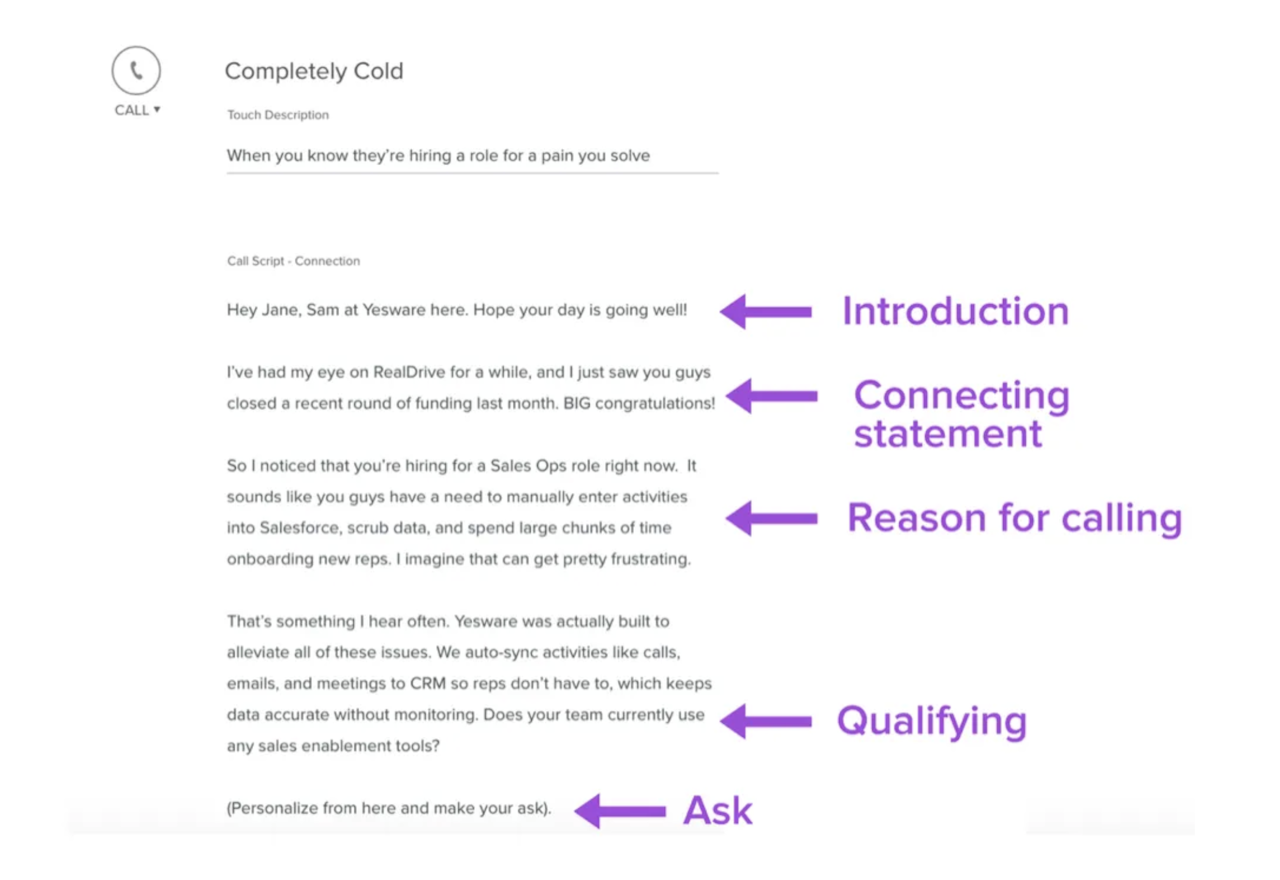
Prior History Outreach
When you’ve already tried and been ghosted, all the more reason to show them personal value. As simple as it sounds, the sweeping majority of sales call scripts lack the “what’s in it for you.”
The prospect you’re calling is a person with a real job, with real needs and frustrations. Connect with that reality. Prove you aren’t just cycling through selling activities with your own agenda.
Forbes contributor Carrie Kerpen puts it perfectly:
“Every cold outreach that I’ve ever given 15 minutes of my time to was because they were memorable, and because I didn’t feel like a tally number on a board of ‘calls made.’ Every single one was about how they could add value to my business in a way that others couldn’t.”
“Want to get me to talk to you? Learn something about me, and deliver it in a way that resonates.”
Here’s how to organize this type of call:
- Introduction
- Context (When you last reached out and why you’re calling)
- Possible Value Prop (PVP)
- Value Prop
- Ask
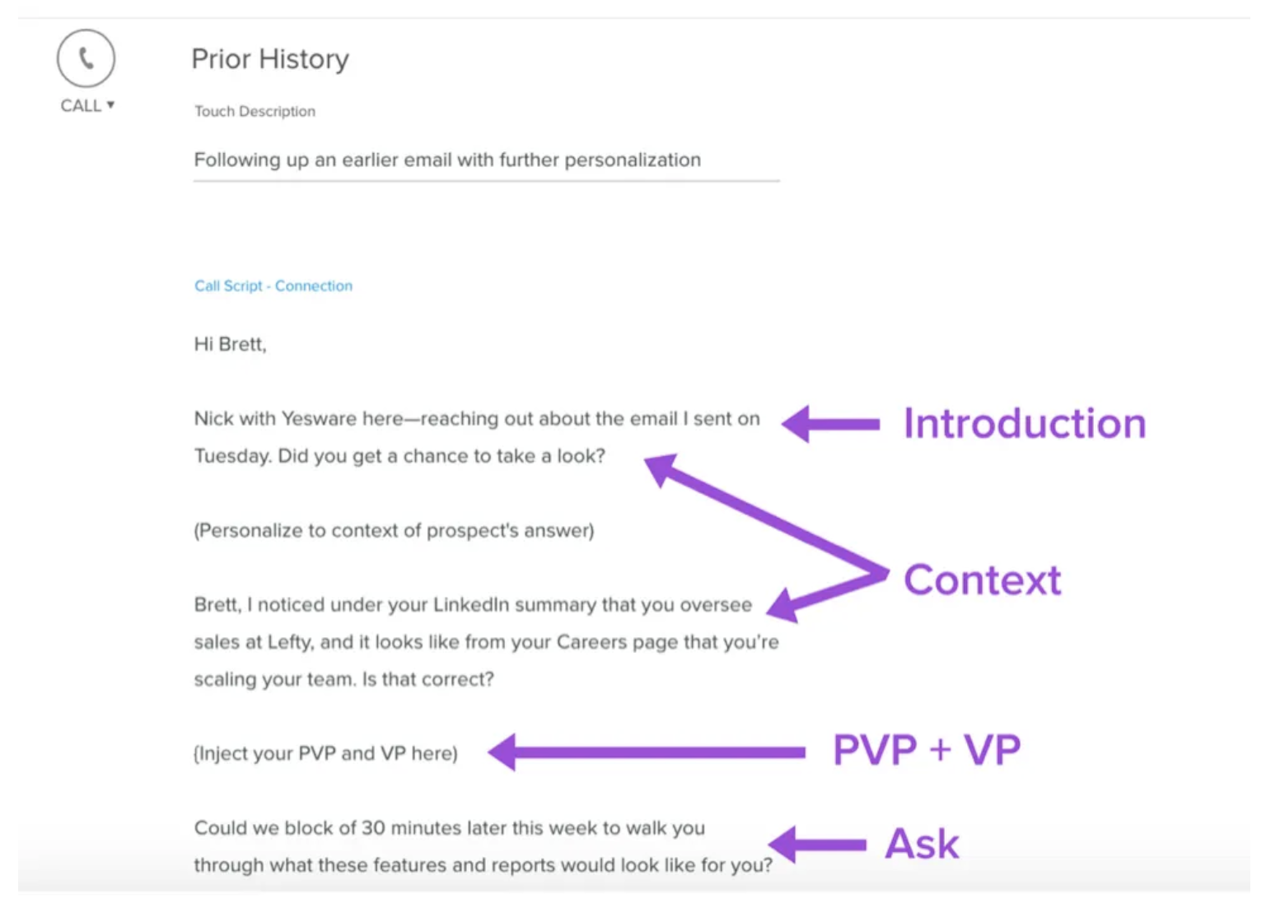
Tip: Grab 30 cold calling scripts here.
Cold Calling Tips
1. Prepare a strong opening sentence
You have ten seconds to prove that you’re worth talking to, so differentiate yourself from other callers. After introducing yourself, turn the focus to your prospect by weaving in your research and personalizing the call.
For example: You could open with a compliment on a recent professional accomplishment you came across through research.
2. Let rejection motivate you
Rejection is inevitable and a necessary part of all sales activity – so use it to motivate you.
Rejection brings emotional pain. We can relive and experience social pain more vividly than physical pain, so it’s easy to get discouraged by a bad call. Don’t be defeated. Keep a positive attitude, pick up the phone and continue learning and improving.
3. Speak only one or two sentences at a time
This cold calling technique is straightforward but often overlooked. Studies show that the brain can only hang onto 20-30 seconds of information at any given time. By that measure, your prospect will likely only retain 30 seconds of a fifteen-minute conversation.
Keep it short and sweet. Rather than overwhelm a stranger with information or industry-specific terminology, speak clearly and stick to high-level explanations.
If your prospect starts asking for specific information, you’ll know they’re interested in learning more. Take this opportunity to set up a meeting when they can discuss any questions in more depth.
4. Overcome call reluctance
Studies show that 80% of new salespeople fail due to call reluctance. It’s completely normal to feel jittery before a cold call, but with the right measures, you’ll be able to conquer that.
Next time you’re feeling nervous, try these tips:
- Use essential oils
- Look at a photo of a loved one
- Look at every call as a learning experience
- Don’t invest everything in the outcome
5. Use social proof to influence behavior
We are easily influenced by other people’s behaviors.
Social proof plays a major role in selling because it shows the prospect that your product has helped other people with similar pain points. Try telling a customer success story of someone who had similar pain points.
Use recognizable company names you believe the prospect will be familiar with – this will influence their opinion and instinctive thoughts on the company.

6. Use trigger events to get your foot in the door
If you contact someone right after they sign a contract with your competitor, chances are they won’t bite.
But if you know exactly when they enter the market for a new vendor and reach out before they start the search, your seemingly serendipitous call may be received with much more interest.
The good news is that the secret to perfect timing isn’t really a secret. You can pick up on these opportune moments — known as trigger events — by keeping tabs on publicly available information that surfaces every day across a variety of online channels.
Use alerts to keep an eye out for things like:
- New executive hires → A new member of the C-suite wants to prove his or her value and may be more open to new ideas than already entrenched business leaders.
- Winning large contracts/large customer announcements → Drop a line to say congratulations.
- Company expansions → A new location or geographic change could be a primary upsell or introduction opportunity.
- Mergers & Acquisitions → If one party is already a customer, this could be a golden opportunity to get your foot in the door and bring in add-on revenue.
- Funding → Your prospect is up to eight times more likely to buy from you after they experience an event where they can afford to change.
- Behavioral indicators → Is your prospect looking at an email you sent? Go get ‘em — you’re more likely to grab their attention while you already have it.
7. Don’t attempt to sell on your first call
The goal of your first call should be to book a meeting, not sell.
On your first call, you want to communicate your reason for calling and the value proposition, but you also want to focus on gathering information on the prospect and their company.
This way when you do attempt to sell, you can tailor your sales pitch around the prospect and their company.
8. Ask open-ended questions
By starting your question with ‘who,’ ‘what,’ ‘where,’ ‘when,’ and ‘how,’ you give your prospect more room for response.
Here are 20 open-ended questions that will get prospects talking.
Cold calling is a two-sided conversation and you want to learn as much as you can about your prospect, what they do, and their needs. By asking how they feel, you open up more opportunities for discussion.
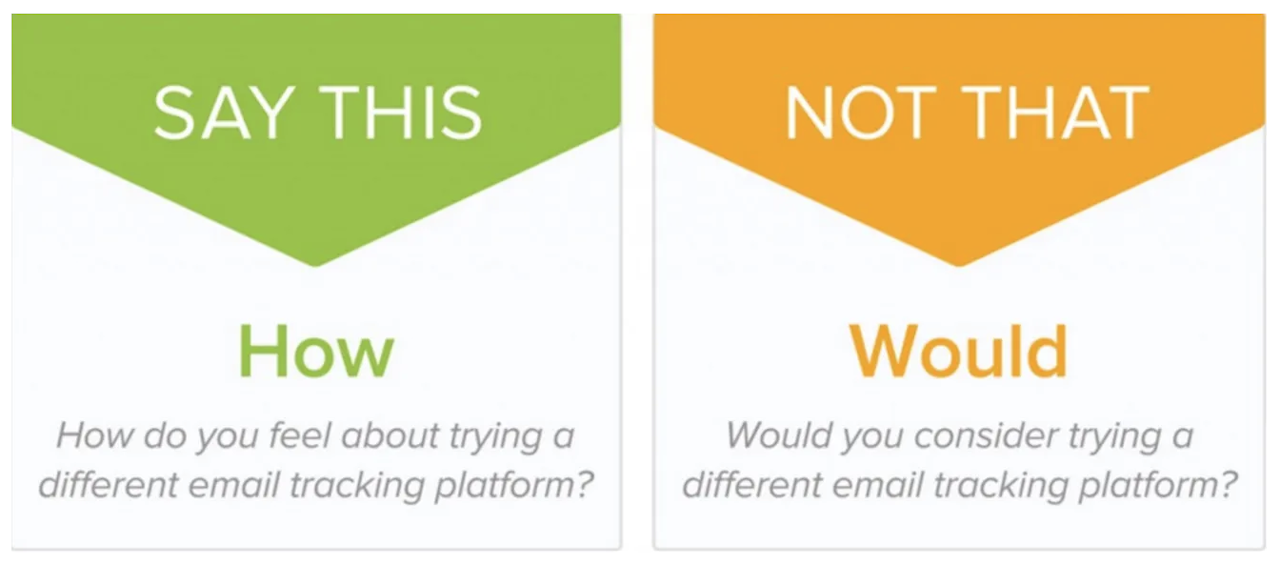
9. Watch your tone of voice
Research indicates that 38% of spoken communication is comprehended by the tone of voice.
Without facial expressions and body cues, you can only convey your points with your words and tone of voice. People respond well to mirroring, so try to match their tone of voice or speech patterns.
10. Lead with them, not you
Fact: People spend 60% of their time talking about themselves.
Self-disclosure produces a burst of activity in neural regions associated with pleasure, motivation, and reward.
Keeping the focus on your prospect works wonders for both parties: your prospect gets to talk about their favorite topic (themselves) and you can gain their attention in interesting, unique ways.
Cold Outreach: Cold Emailing
The next cold outreach we’ll discuss is cold emailing.
This section pulls tons of data-backed strategies and original studies.
Let’s dive into cold emailing steps, formulas, templates, and tips.
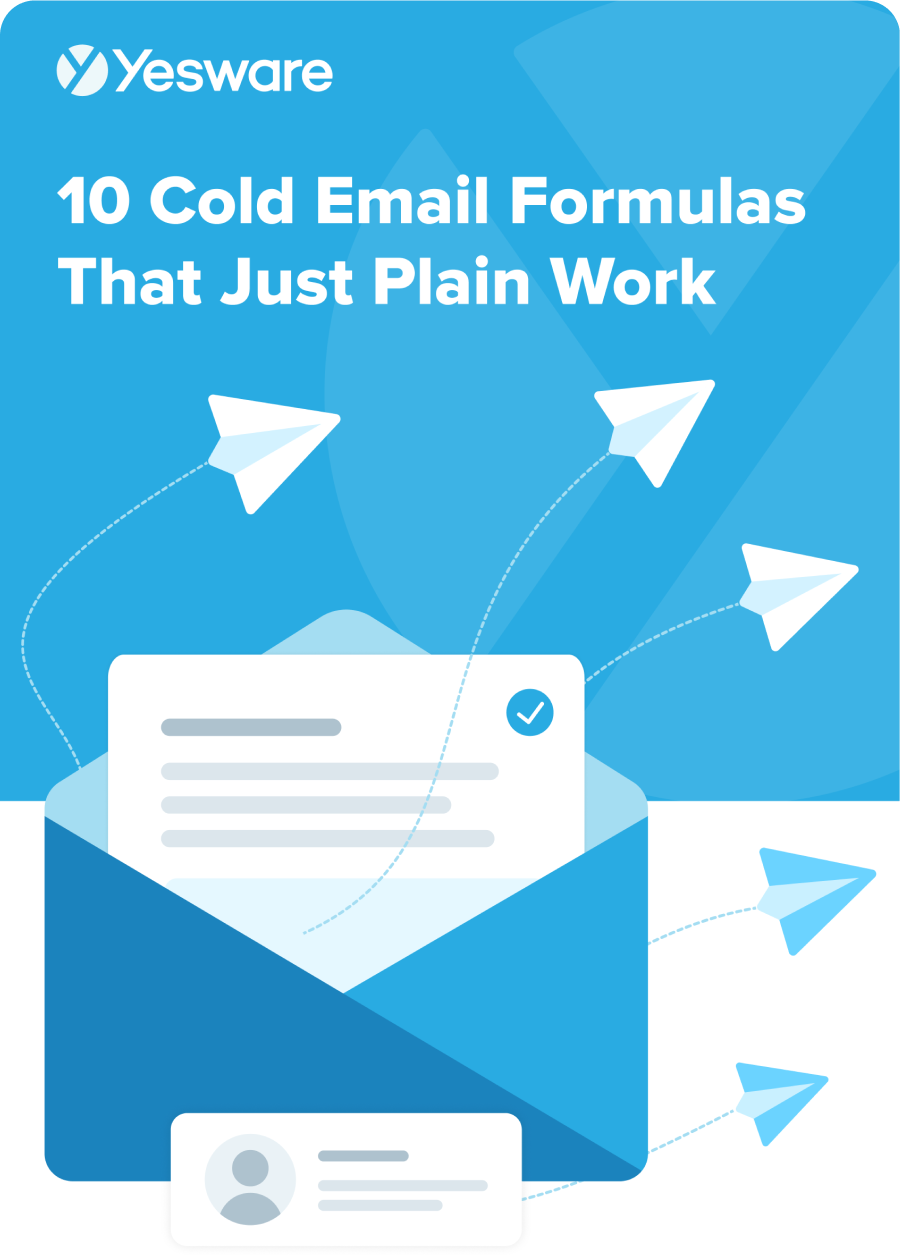 10 Cold Email Formulas That Just Plain WorkSee how B2B sales professionals are using these cold email templates to engage more prospects, fill the top of their funnel and build more sales pipeline faster.
10 Cold Email Formulas That Just Plain WorkSee how B2B sales professionals are using these cold email templates to engage more prospects, fill the top of their funnel and build more sales pipeline faster.
Cold Emailing Steps
First step: Research
Take a minute and look up the prospect online. Did their company do something recently? The prospect? Did their quarter just end? Did their local sports team just win? Find something relevant to them, and include it in your email prospecting.
Steps to take:
- Check your CRM system
- Check the company website: About Us, Careers / Open Positions, News, Blog.
- Social channels
- Company updates
After this, you can personalize and tailor your message to the prospect appropriately and effectively.
Second step: Write a clear and concise email
Write a clear, concise, and personalized email.
Your cold email should incorporate these aspects:
- Clear introduction
- Reason for emailing
- Clear value proposition
- The offer
- Call-to-action
- Appropriate email signature
Read below for effective formulas and templates to help you craft an effective cold email.
Third step: Make sure you have a clear subject line
The best cold email subject lines should check all of these boxes:
- Be between 1-5 words in length
- Summarize the intention of your email body
- Tie nicely with the first line of your email body
- Reflect type of email (initial, reply, forward, or follow up) (i.e. “re,” “fwd,” “next steps”)
- Get the attention of recipients who are strangers and “pop” when they scan their inbox
In a recent Yesware study that analyzed 265,000 sales templates, we found that the most successful emails based on open and reply rates had subject lines between 1-5 words.
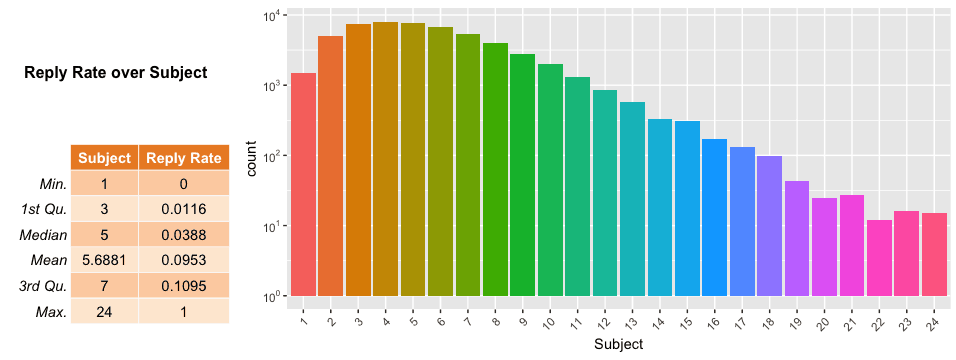
This supports our common belief that clear and concise is key to generating the perfect subject line.
Your subject line should describe the contents of the message concisely but remain short enough for your recipient to read it on their phone.
In another Yesware study from 2017 that analyzed email subject lines, the key takeaways were:
- Language that shows immediacy is the most effective.
- Asking someone “can you chat?” will lose you 98 out of 100 emails.
- Using “next steps” in your follow-up email subject line can score you a 70% open rate.
- “Follow-up” gets 16% more opens, 18% more replies than similar variations.
- The phrase “touching base” falls flat half the time.
Fourth step: Send your email at the right time
In our Top Sales Statistics of 2020 blog, our top sales stat was that most emails are opened at the end of the workday, peaking at 3pm.
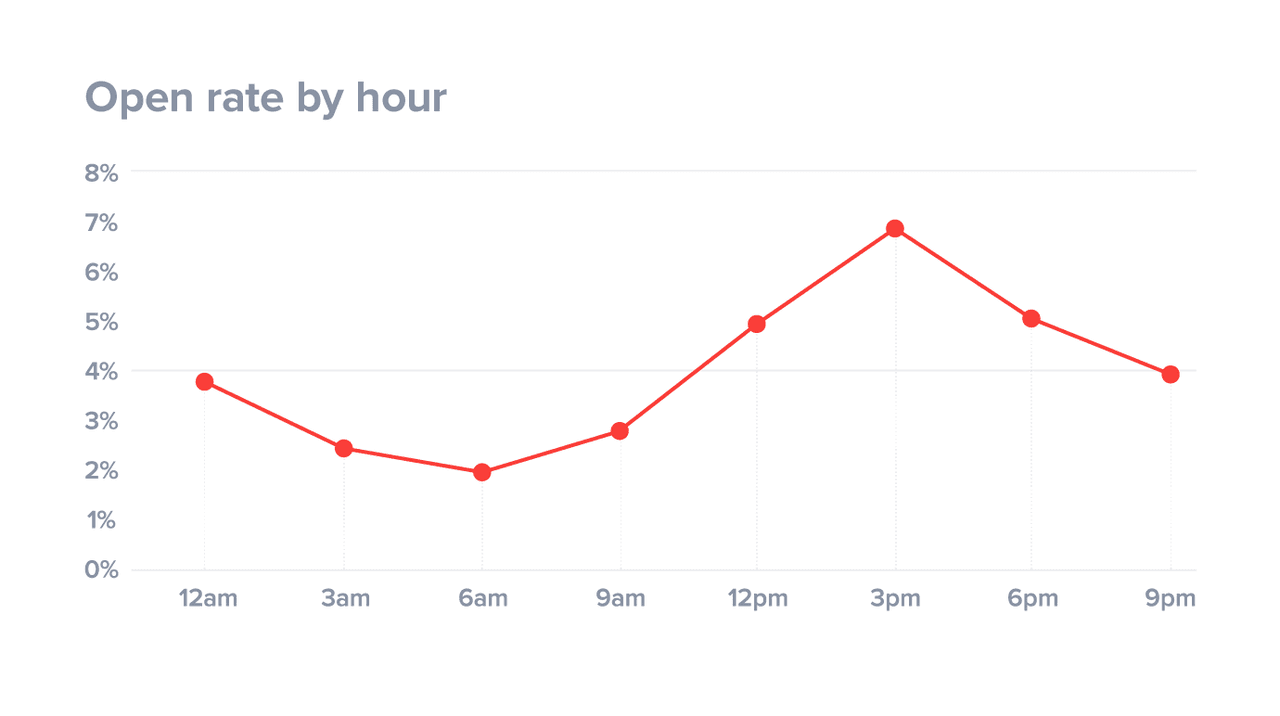
Optinmonster found that open rates peaked at 3pm, suggesting that Tuesday after 1pm is your best bet.
Mailchimp found that the majority of emails are opened between 2pm – 5pm which means sending your email in the morning can jeopardize your chances of reaching your recipient, getting lost in the clutter of their inbox.
Similar to the best time to call, see what works best for you and where you get the most success.
Yesware users: You have a Best Time to Send Tool right in your inbox to help you schedule your emails at a time they’re most likely to be opened.
Last step: After pressing send, always follow up
Always schedule a follow-up email after clicking send so you don’t forget.
On average, it takes at least 5 follow-ups after the initial contact before a customer says yes.
Studies show that 92% of salespeople give up after four “no”s, but 80% of prospects say “no” four times before they say “yes.”
So, following up is crucial to implementing your cold email outreach strategy.
Cold Emailing Templates & Formulas
1. Before-After-Bridge (BAB)
Before — Here’s your world now
After — Imagine what the world would be like if you solved this problem
Bridge — Here’s how to get there
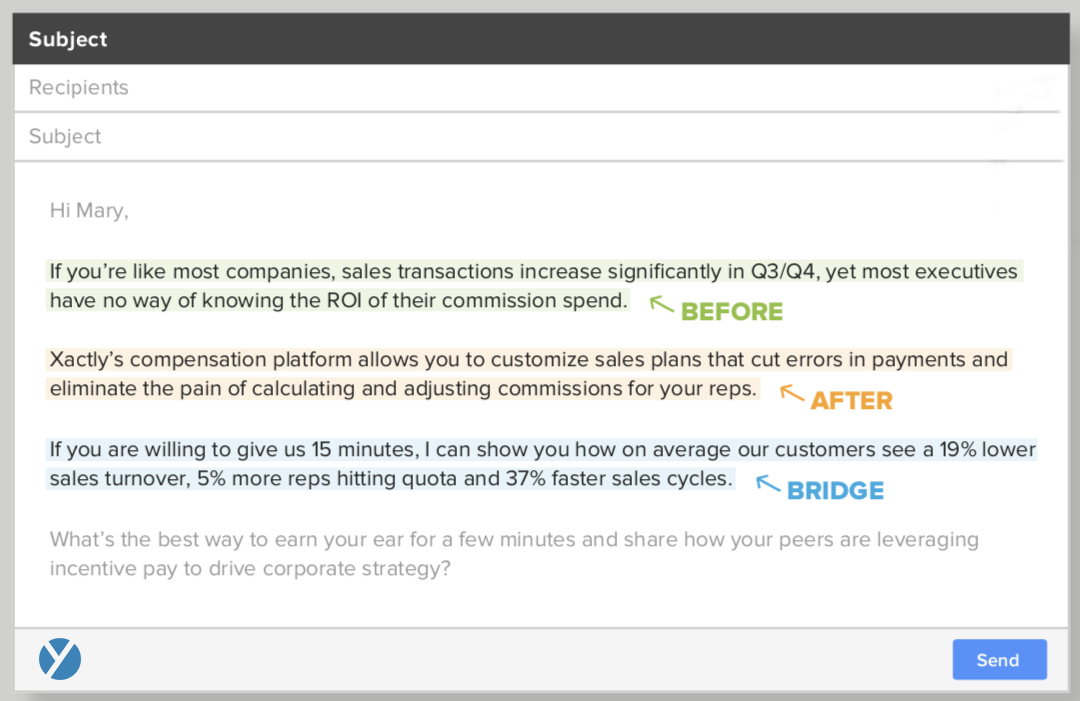
Open by describing a problem that is relevant to your prospect, and then describe how the world would be different if that problem didn’t exist. Close by explaining how your product/idea/service can help them get there.
Why it works: According to behavioral psychologists, humans are motivated to take action by two things: pleasure and pain. The BAB formula uses this universal trigger to compel readers to respond.
2. Problem-Agitate-Solve (PAS)
Problem — Identify a pain point
Agitate — Agitate that pain point
Solve — Offer a solution
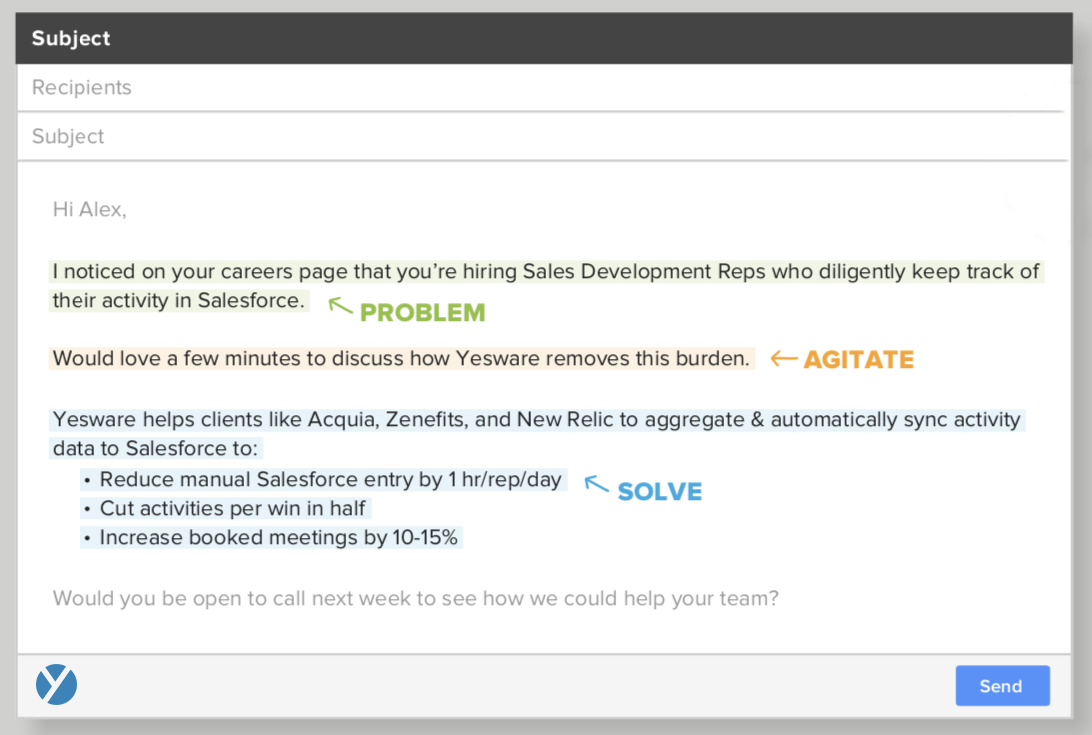
Instead of imagining life without the problem (the “After” stage), PAS calls out the dangers in the road from point A to B and explains how your product is the weapon they need to win.
Why it works: Because pain is even more motivating than pleasure. People want to avoid the hassle, problems, and unnecessary burdens.
3. Star-Chain-Hook
Star — The big idea
Chain — A series of facts, sources, reasons, and benefits
Hook — The call to action
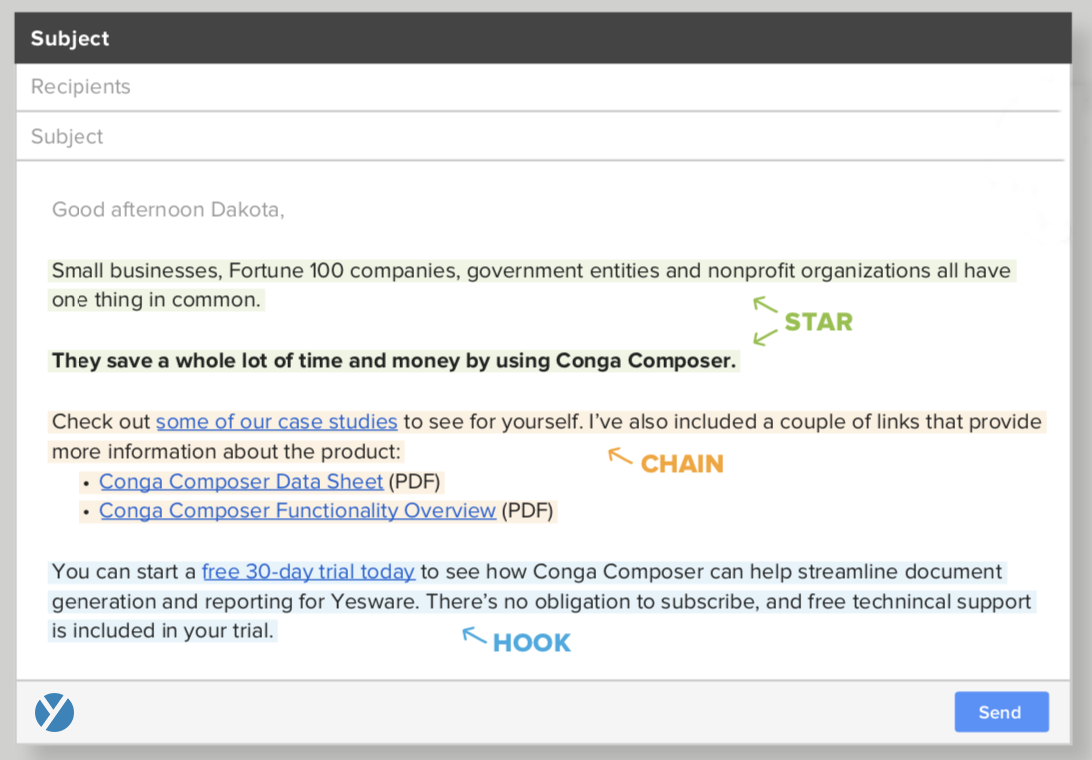
Introduce your idea with an attention-grabbing opening. Create a chain of supporting facts, sources, and benefits to build credibility and transform attention into interest. Then, hook them with a call to action that makes it easy to take the desired next step.
Why it works: The key element in this cold call email formula is the chain. By introducing proof points that lend credibility to your argument, you have a better shot at convincing someone to follow through.
4. Praise-Picture-Push (3P’s)
Praise — Open with a sincere, respectful compliment
Picture — Use cause-and-effect reasoning to paint a picture describing how your product/service/idea will deliver
Push — Ask them to commit
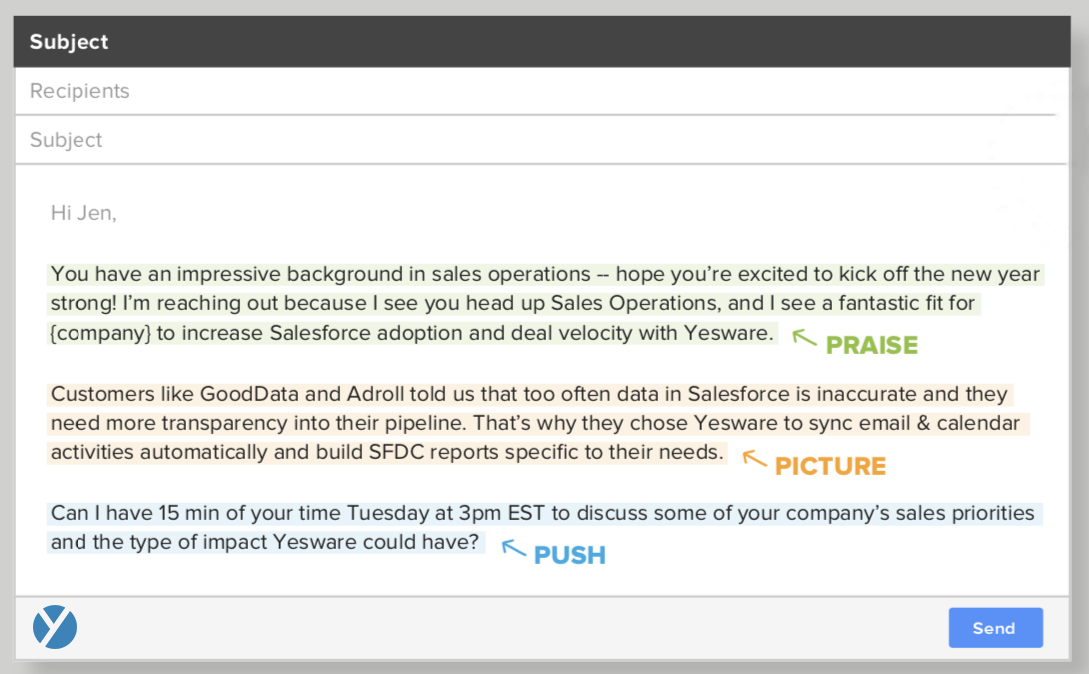
Why it works: The “3P” cold email formula is rooted in psychology.
Praise — To the brain, receiving a compliment is as much a social reward as receiving cash.
Picture — Studies show that when a person explains cause-and-effect, it builds trust and lends more weight to their argument.
Push — Explain some, but not all, of what the reader will get if they respond. It’s what we don’t know that makes us want to investigate, discover, and agree to learn more.
If you want more formulas – access all 10 of Yesware’s formulas here.
Tip: If you’re new to cold emailing – try building out a library of email templates. Try different formulas and templates out, see what works and doesn’t work, and edit your library accordingly.
Yesware does it for you.
If you want to get started building a library of templates, here are some cold outreach templates to help you begin:
Cold Outreach: Do their research for them
Subject line: Articles for your commute home
Hi {!First name},
The last few calls I’ve had with companies like yours who {!specific stats about the recipient’s company} have led me to research {!topic that could be a pain point for them}.
I thought you would appreciate these articles. I thought they did a great job at addressing {!pain point}:
{!Link to content 1} – {!description of content 1}
{!Link to content 3} – {!description of content 2}
{!Link to content 3} – {!description of content 3}
If these resonate with you, let’s grab 15 minutes to see if {!your Company} can help by {!proposed solution for solving pain point}.
Is there a day or time that generally works best for you?
Why this email template works:
Establishing credibility is key to gaining your prospect’s trust.
Humans naturally fear the unknown. A tip to overcome their resistance is to mention a similar business you’ve worked with and how you’ve helped that company. Do your research and demonstrate your industry expertise by offering guidance and solutions to their pain points. Build rapport by providing them relevant and helpful content.
Cold Outreach: Compliment recent accomplishment
Subject line: Congrats on {!Recent accomplishment}
Hi {!First name},
Congratulations on {!describe recent personal or company accomplishment}. I hope you and your team are taking some time to celebrate the accomplishment.
I’m sure you’re very busy, but I’d love to get your take on how could {!solve a specific problem they’re facing or provide a specific benefit they need}.
Do you have 10 minutes sometime over the next couple weeks to chat? More than happy to work around your schedule or to try again at a more convenient time, just let me know.
All the best and congrats again!
Why this email template works:
This template is engaging because it centers around them, not you.
This email cuts to the chase without being pushy. You engage the prospect immediately by focusing on their accomplishments. After you have their attention, you propose how your product or service can benefit them by asking for their frame of reference. To finalize it off, you offer flexible scheduling that centers around their agenda.
If you want more email templates – access our free Template Library here – copy and use these templates today.
Cold Emailing Tips
1. Write like you talk
Read your email out loud before you click send and make sure the wording flows and sounds natural. The worst thing you can do is send an email that sounds robotic and scripted. Make it personable and conversational.
Also: when you read the email out loud to yourself – do you find it valuable? How would this message affect you if you found it in your inbox. Put yourself in the recipient’s shoes and you will find yourself writing more effective and valuable messages.
2. Make the first line about them
When sending a cold email – you need to introduce yourself in a way that’ll hook your recipient.
The first line is the most important part of your email – whatever you do, make it about them.
“I saw your post about _____”
“I noticed you manage _____”
“Congratulations on _____”
“Great insights on _____”
“I’m inspired by the work you’ve done on _____”
The best way to hook your recipient right away is to acknowledge them and make it known you’ve done your research.
3. Warm-up your cold leads by providing them value
Use the Power of Reciprocity to your advantage in your cold outreach.

It’s an instinctual human condition to feel that you owe something to someone who has provided you helpful insight and value.
Ways you can do this:
- Invite them to a conference or event
- Introduce a business connection or a possible candidate
- Provide a research brief or business advice
- Provide a valuable and relevant article
- Engage on LinkedIn
4. Asking only one question is ideal
All else being equal, emails that contain a question tend to receive higher reply rates. In a recent Yesware study, we analyzed 265,000 sales templates and found that the most effective question count based on open and reply rates is right at one question. That’s right – just 1.
Too many questions can overwhelm the recipient. Respondents tend to answer only one question regardless of how many you ask, so save yourself time and stick to one question per template. And make sure this question will move the conversation forward.
5. Create an effective subject line
The best email subject lines should check all of these boxes:
- Be between 1-5 words in length
- Summarize the intention of your email body
- Tie nicely with the first line of your email body
- Reflect type of email (initial, reply, forward, or follow up) (i.e. “re,” “fwd,” “next steps”)
- Get the attention of recipients who are strangers and “pop” when they scan their inbox
Remember, the best email subject lines stop you in your tracks as you skim through your inbox. Make it engaging, personalized to the recipient, and unique.
Co-founder of Yesware, Matthew Bellows, suggests: “Getting through the personal spam filters is all about being specific in your subject line, immediately adding value, and not being too sales-y. For this purpose, I suggest a tight and directed subject line.”
Bellows found these subject lines work well for him:
Congratulations subject lines – “Congrats on the product release/great quarter/NYT coverage/financing/new customer” (the more specific the better). If you are writing to the head of product development, product or feature messages are best. Want to meet with the VP of Sales? They all like congratulations on a great quarter.
Praise subject lines – “I’ve heard about your skills and wanted to get in touch” or “I’ve been following your efforts/blog/tweets/sales success for quite a while and wanted to reach out”. The key here is to be genuine, impressed, but not fawning. If you have no backbone, no one wants to hear your praise. On the other hand, if you are haughty, why are you writing?
Adding value subject lines – “Hi Ted! I found an article on [your industry/competition/field] and thought of you” I start out with using the prospect’s name so they know it’s not spam, and then immediately let them know that the message is relevant to their work life. Using the person’s name like that can work well in the other types of sale emails as well.
6. Always follow up
As stated above, following up is critical to any cold outreach strategy.
If you think you might forget, schedule your email to be sent later.
If you need templates for following up – access some free templates in our Template Library and use them in your strategy today.
7. Use statistics in your cold email
Research proves we’re more motivated by pain than pleasure. First, use statistical evidence to hit your prospect’s pain point. Next, help them envision how your product will help them solve it.
How it works:
- Statistics: Performance statistics catch our attention and give whoever uses them an aura of authenticity. Here, they serve as the hook and introduce the problem.
- The reality about most teams: Here, you use another statistic to show that you aren’t alone. Times are tough for most teams. But they don’t have to be; there’s a way that you can come out ahead of the rest…
- Includes benefits: Then, pose your benefits so they become the easy way out of tough reality. Like when you see a Sarah McLachlan commercial and feel the impulse to sign up for a monthly donation. Case in point: that commercial raised $30 million dollars.
8. Provide social proof
We base our judgments on other people, so throwing in some customer names and testimonials from people similar to us can make us more likely to buy.
Psychology studies show that social forces influence people’s judgments and we tend to base decisions on other’s actions. And it applies to everyday life – purchasing decisions being one of them.
There are many ways you can go about adding social proof to your cold emails such as adding quotes from customers who are in a similar role to your prospect or mentioning three recognizable company names in your email.
Here are some powerful forms of social proof:
- Customer testimonials
- Ratings and reviews
- Social media shares
- Case studies
- Influencer endorsements
Make sure the social proof is relevant and caters to your prospect.
9. Emails should range between 50-125 words
Our data shows that the average Yesware email clocks in at 132 words. While this may seem concise, it’s actually a bit too wordy. Research shows that the ideal email length is 50-125 words. To be exact, 75 word emails are optimal.
Our most exciting finding in this study was hard proof that mass emails don’t work. Templates sent at a high volume consistently yielded lower reply rates. Highly personable templates that are low volume are most effective. And keep in mind to always refresh your templates and don’t overuse your old ones.
10. Use their name more than once
Studies show that using the recipient’s name more than once in your email has a positive effect.
This not only shows that you aren’t just sending a generic sales template, but research indicates: “Our names are intrinsically tied to our self-perception and make up a massive part of our identity. No surprise then, that we become more engaged and even more trusting of a message in which our name appears.”
What it means: Personalization is key. Try catching their eye by placing their name in the subject line — i.e. “Hi Jim, it’s Jenny from Yesware.” Asking for a reply that requires more than a simple yes/no? Throw in a simple “Thanks for your time, Jim” to close out your email.
Reignite your Cold Outreach Strategy
Remember, no one has the perfect formula for cold outreach. The key is to try different methods and techniques and see what works and doesn’t work. And revise your cold outreach strategy accordingly.
With every outreach, always keep top-of-mind how important personalization is. Try to always warm up your cold emails and cold calls with personalization and you’ll find success in your cold outreach strategy in no time.
We hope these tips, techniques, formulas, and stats can help you get there.
Bonus: Watch Our Webinar — Navigating Cold Outreach During Uncertain Times
Get sales tips and strategies delivered straight to your inbox.
Yesware will help you generate more sales right from your inbox. Try our Outlook add-on or Gmail Chrome extension for free, forever!
Related Articles
Anya Vitko
Jenny Keohane
Casey O'Connor
Sales, deal management, and communication tips for your inbox

